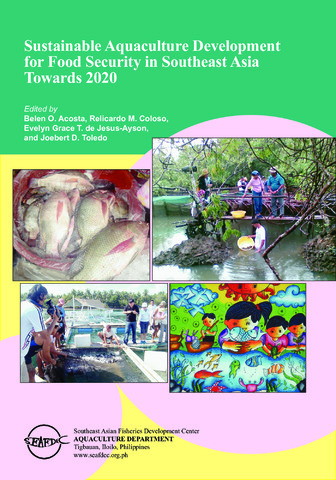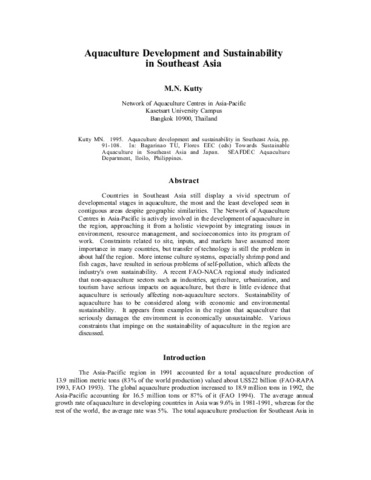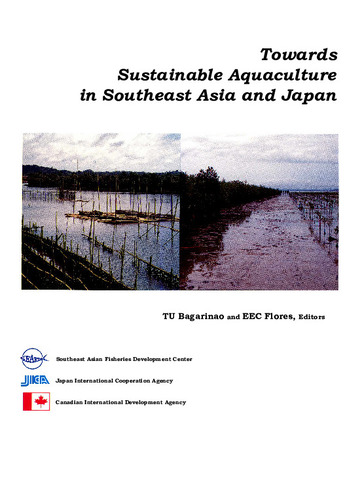Development of a sustainable mangrove crab industry through science-based research
Share
Abstract
Farming of mangrove crab (or mud crab) species, e.g. Scylla serrata, S. tranquebarica and S. olivacea has long been established in the Philippines although the preferred species for growing is S. serrata. The Philippines’ total production of mangrove crab from aquaculture in 2013 was estimated at 16,160 metric tons valued at PhP 5.2 billion, making the country the second top producer of mangrove crab in the world (FAO, 2015). The sources of crab seeds for farming are from the wild and in recent years, a small percentage from hatcheries. Degradation of the natural habitat and uncontrolled collection of all sizes of crabs have resulted in the depletion of the natural population of mangrove crab. As a stopgap measure, the Bureau of Fisheries and Aquatic Resources (BFAR) together with the provincial and municipal government issued ordinances that prohibit the gathering and selling of crablets (≤3 cm) outside the municipality of origin to reduce not only the volume of harvest from the natural habitat but also the collection and trading of ovigerous (berried) females. This has resulted to increased acceptability of hatchery-reared crab juveniles by crab growers. Through the R&D efforts of the Philippine-based SEAFDEC Aquaculture Department, dissemination of sustainable management of mangrove crab culture to the region has been intensified for a sustainable mangrove crab industry in Southeast Asia.
Suggested Citation
Quinitio, E. T., & Parado-Estepa, F. D. (2017). Development of a sustainable mangrove crab industry through science-based research. Fish for the People , 15(1), 47-51. http://hdl.handle.net/20.500.12066/1008
Paksa
aquaculture development  ; aquaculture economics
; aquaculture economics  ; aquaculture regulations
; aquaculture regulations  ; brackishwater aquaculture
; brackishwater aquaculture  ; commercial species
; commercial species  ; crab culture
; crab culture  ; culture effects
; culture effects  ; cultured organisms
; cultured organisms  ; environmental degradation
; environmental degradation  ; fishery regulations
; fishery regulations  ; marine crustaceans
; marine crustaceans  ; resource management
; resource management  ; seed production
; seed production  ; sustainable aquaculture
; sustainable aquaculture  ; sustainability
; sustainability  ; Scylla serrata; South East Asia; Philippines; hatcheries
; Scylla serrata; South East Asia; Philippines; hatcheries 
 ; aquaculture economics
; aquaculture economics  ; aquaculture regulations
; aquaculture regulations  ; brackishwater aquaculture
; brackishwater aquaculture  ; commercial species
; commercial species  ; crab culture
; crab culture  ; culture effects
; culture effects  ; cultured organisms
; cultured organisms  ; environmental degradation
; environmental degradation  ; fishery regulations
; fishery regulations  ; marine crustaceans
; marine crustaceans  ; resource management
; resource management  ; seed production
; seed production  ; sustainable aquaculture
; sustainable aquaculture  ; sustainability
; sustainability  ; Scylla serrata; South East Asia; Philippines; hatcheries
; Scylla serrata; South East Asia; Philippines; hatcheries 
Mga koleksyon
Related items
Showing items related by title, author, creator and subject.
-
Sustainable aquaculture development for food security in Southeast Asia towards 2020. Proceedings of the Regional Technical Consultation on Sustainable Aquaculture Development in Southeast Asia Towards 2020
Acosta, Belen O.; Coloso, Relicardo M.; de Jesus-Ayson, Evelyn Grace T.; Toledo, Joebert D. (Aquaculture Department, Southeast Asian Fisheries Development Center, 2011)This publication represents the proceedings of the Regional Technical Consultation (RTC) on Aquaculture held in Bangkok, Thailand last 17-19 March 2010. The RTC was convened by the Southeast Asian Fisheries Development ... -
Aquaculture development and sustainability in Southeast Asia
Kutty, M. N. (Aquaculture Department, Southeast Asian Fisheries Development Center, 1995)Countries in Southeast Asia still display a vivid spectrum of developmental stages in aquaculture, the most and the least developed seen in contiguous areas despite geographic similarities. The Network of Aquaculture Centres ... -
Towards sustainable aquaculture in Southeast Asia and Japan : proceedings of the Seminar-Workshop on Aquaculture Development in Southeast Asia, Iloilo City, Philippines, 26-28 July 1994
Bagarinao, Teodora, U.; Flores, Efren Ed C. (Aquaculture Department, Southeast Asian Fisheries Development Center, 1995)Documents the presentations at ADSEA '94, the 3rd Seminar-Workshop on Aquaculture Development in Southeast Asia. ADSEA '94 includes reviews of the status of aquaculture development in Southeast Asia and Japan and of the ...




